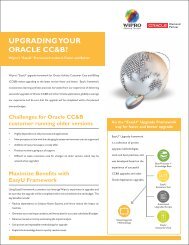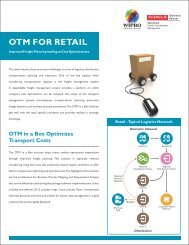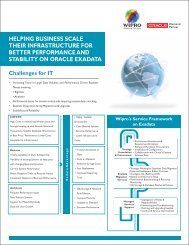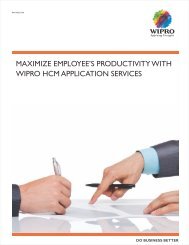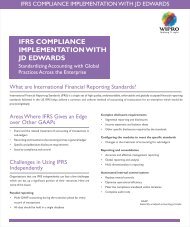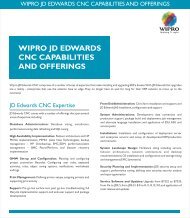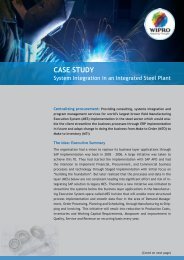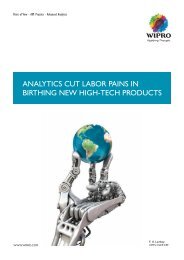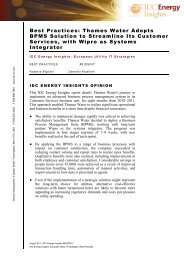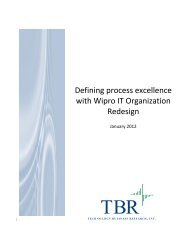Knowledge Management Strategies for Mitigating the Big Crew - Wipro
Knowledge Management Strategies for Mitigating the Big Crew - Wipro
Knowledge Management Strategies for Mitigating the Big Crew - Wipro
You also want an ePaper? Increase the reach of your titles
YUMPU automatically turns print PDFs into web optimized ePapers that Google loves.
<strong>Knowledge</strong> <strong>Management</strong> <strong>Strategies</strong> <strong>for</strong> mitigating <strong>the</strong> <strong>Big</strong> <strong>Crew</strong> Change in E&P<br />
[4] [5] [6] The average age of oil field engineers is 48 and 50% to 60% will be eligible <strong>for</strong> retirement within 10 years. The expected<br />
attrition rate is 6% per year.7 The disciplines hardest hit include petroleum engineers, process engineers, geologists, and<br />
geophysicists. Employee age also follows a bimodal distribution with a large number of older employees, a number of younger<br />
employees and not much in <strong>the</strong> middle. A good example is Halliburton, where 56% of employees have less than five years of<br />
experience, 17% have 5 to 10 years’ experience, and 27% have more than 10 years’ experience.8 Halliburton is considered a<br />
young company in <strong>the</strong> industry with bimodal distribution over-weighted at <strong>the</strong> young side of <strong>the</strong> curve. Aramco is a similar<br />
example. According to Allah Al-Saif, Senior VP of E&P, "nearly half of our work<strong>for</strong>ce [Saudi Aramco] is less than 30 years of age.<br />
Fur<strong>the</strong>rmore, surveys suggest that in <strong>the</strong> next few years more than 60 per cent of our engineers will have less than 10 years of<br />
experience”.<br />
The industry will be most at risk when <strong>the</strong> experienced employees retire, shifting <strong>the</strong> small middle group into leadership with<br />
support from a large group of inexperienced employees.<br />
Work<strong>for</strong>ce volatility is not new to <strong>the</strong> oil and gas industry; it has been an issue <strong>for</strong> <strong>the</strong> last 150 years. As <strong>the</strong> price of oil climbs,<br />
companies quickly hire. As oil prices fall, companies lay off. Since <strong>the</strong> 1980s <strong>the</strong> price of oil has gone from <strong>the</strong> $10s to <strong>the</strong> $140s<br />
and back to <strong>the</strong> $50s today. The work<strong>for</strong>ce demographics reflect this. However, oil price volatility is only one component. The <strong>Big</strong><br />
<strong>Crew</strong> Change has its roots in <strong>the</strong> 1980s and 1990s and occurred <strong>for</strong> three reasons:<br />
1. Mergers and low oil prices caused hundreds of thousands of people to leave <strong>the</strong> industry<br />
2. The image of E&P as low-tech and a dirty, sunset industry makes it less attractive <strong>for</strong> young people<br />
3. Competition from o<strong>the</strong>r industries<br />
There is also a regional graduation deficit <strong>for</strong> E&P engineers. The US enrolment in key E&P industry skills like petroleum<br />
engineering fell 85% between 1982 and 2003. For example, in 1993 <strong>the</strong>re were 11,000 petroleum engineering students in <strong>the</strong><br />
United States at 34 universities. By 2005, that number had plummeted to 1700 people at 17 universities. 10While <strong>the</strong> situation<br />
in <strong>the</strong> United States is grim, in parts of <strong>the</strong> world such as India and China <strong>the</strong>re is a surplus.<br />
In 2006, Schlumberger Business Consulting surveyed 115 universities and 30 companies to compare available labor and<br />
demand.11 The results of <strong>the</strong> survey showed major deficits in <strong>the</strong> United States, Canada, Russia, Saudi Arabia and Iran. Major<br />
surpluses were found in China, Indonesia, India, Venezuela and Mexico. The deficits and surpluses roughly balance <strong>the</strong>mselves.<br />
One of <strong>the</strong> challenges going <strong>for</strong>ward will be to ei<strong>the</strong>r relocate <strong>the</strong>se engineers closer to <strong>the</strong>ir work or to find new ways to<br />
leverage <strong>the</strong>m in <strong>the</strong>ir native countries.[7] [8]<br />
6 | www.wipro.com/industryresearch<br />
WIPRO TECHNOLOGIES




